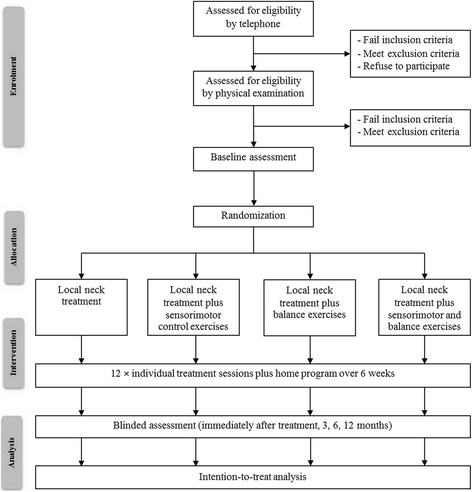Effects of local treatment with and without sensorimotor and balance exercise in individuals with neck pain: protocol for a randomized controlled trial
- PMID: 29433500
- PMCID: PMC5809984
- DOI: 10.1186/s12891-018-1964-3
Effects of local treatment with and without sensorimotor and balance exercise in individuals with neck pain: protocol for a randomized controlled trial
Abstract
Background: Impaired cervical joint position sense and balance are associated with neck pain. Specific therapeutic exercise and manual therapy are effective for improving neck pain and functional ability but their effects on joint position sense and balance impairments remain uncertain. Changes in the joint position sense and balance may need to be addressed specifically. The primary objective is to investigate the most effective interventions to improve impaired cervical joint position sense and balance in individuals with neck pain. The secondary objective is to assess the effectiveness of the interventions on pain intensity and disability, pain location, dizziness symptoms, cervical range of motion, gait speed, functional ability, treatment satisfaction and quality of life.
Methods: A 2 × 2 factorial, single blind RCT with immediate, short- and long-term follow-ups. One hundred and sixty eight participants with neck pain with impaired joint position sense and balance will be recruited into the trial. Participants will be randomly allocated to one of four intervention groups: i) local neck treatment, ii) local treatment plus tailored sensorimotor exercises, iii) local treatment plus balance exercises, and iv) local treatment plus sensorimotor and balance exercises. Participants receive two treatments for 6 weeks. Primary outcomes are postural sway and cervical joint position error. Secondary outcomes include gait speed, dizziness intensity, neck pain intensity, neck disability, pain extent and location, cervical range of motion, functional ability, perceived benefit, and quality of life. Assessment will be measured at baseline, immediately after treatment and at 3, 6, 12 month-follow ups.
Discussion: Neck pain is one of the major causes of disability. Effective treatment must address not only the symptoms but the dysfunctions associated with neck pain. This trial will evaluate the effectiveness of interventions for individuals with neck pain with impaired cervical joint position sense and balance. This trial will impact on clinical practice by providing evidence towards optimal and efficient management.
Trial registration: ClinicalTrials.gov ( NCT03149302 ). May 10, 2017.
Keywords: Balance; Exercises; Manual therapy; Neck pain; Sensorimotor control.
Conflict of interest statement
Ethics approval and consent to participate
This trial was approved by the ethical review committee for research in humans, Faculty of Associated Medical Sciences, Chiang Mai University (AMSEC-60EX-018:175/2560). The trial was conducted in accordance with the Declaration of Helsinki. All participants will be provided information about the study and enrolled into the trial if they meet all eligibility criteria and voluntarily sign an informed consent statement.
Consent for publication
Not applicable.
Competing interests
The authors declare that they have no competing interests.
Publisher’s Note
Springer Nature remains neutral with regard to jurisdictional claims in published maps and institutional affiliations.
Similar articles
-
Effectiveness of adding rehabilitation of cervical related sensorimotor control to manual therapy and exercise for neck pain: A randomized controlled trial.Musculoskelet Sci Pract. 2023 Feb;63:102690. doi: 10.1016/j.msksp.2022.102690. Epub 2022 Nov 12. Musculoskelet Sci Pract. 2023. PMID: 36414518 Clinical Trial.
-
Efficacy of manual therapy treatments for people with cervicogenic dizziness and pain: protocol of a randomised controlled trial.BMC Musculoskelet Disord. 2012 Oct 18;13:201. doi: 10.1186/1471-2474-13-201. BMC Musculoskelet Disord. 2012. PMID: 23078200 Free PMC article. Clinical Trial.
-
A Comparison of the Effects of Stabilization Exercises Plus Manual Therapy to Those of Stabilization Exercises Alone in Patients With Nonspecific Mechanical Neck Pain: A Randomized Clinical Trial.J Orthop Sports Phys Ther. 2016 Feb;46(2):44-55. doi: 10.2519/jospt.2016.5979. Epub 2016 Jan 11. J Orthop Sports Phys Ther. 2016. PMID: 26755405 Clinical Trial.
-
Sensorimotor function and dizziness in neck pain: implications for assessment and management.J Orthop Sports Phys Ther. 2009 May;39(5):364-77. doi: 10.2519/jospt.2009.2834. J Orthop Sports Phys Ther. 2009. PMID: 19411769 Review.
-
Effects of deep cervical flexor training on impaired physiological functions associated with chronic neck pain: a systematic review.BMC Musculoskelet Disord. 2018 Nov 28;19(1):415. doi: 10.1186/s12891-018-2324-z. BMC Musculoskelet Disord. 2018. PMID: 30486819 Free PMC article.
Cited by
-
Effects of Global Postural Reeducation versus Specific Therapeutic Neck Exercises on Pain, Disability, Postural Control, and Neuromuscular Efficiency in Women with Chronic Nonspecific Neck Pain: Study Protocol for a Randomized, Parallel, Clinical Trial.Int J Environ Res Public Health. 2021 Oct 12;18(20):10704. doi: 10.3390/ijerph182010704. Int J Environ Res Public Health. 2021. PMID: 34682453 Free PMC article.
-
Cervical Proprioception Impairment in Neck Pain-Pathophysiology, Clinical Evaluation, and Management: A Narrative Review.Pain Ther. 2021 Jun;10(1):143-164. doi: 10.1007/s40122-020-00230-z. Epub 2021 Jan 12. Pain Ther. 2021. PMID: 33464539 Free PMC article. Review.
-
Effects of Two Exercise Regimes on Patients with Chiari Malformation Type 1: a Randomized Controlled Trial.Cerebellum. 2023 Apr;22(2):305-315. doi: 10.1007/s12311-022-01397-1. Epub 2022 Mar 24. Cerebellum. 2023. PMID: 35325392 Clinical Trial.
-
A Comparison of the Effects of Stochastic Resonance Therapy, Whole-Body Vibration, and Balance Training on Pain Perception and Sensorimotor Function in Patients With Chronic Nonspecific Neck Pain: Protocol for a Randomized Controlled Trial.JMIR Res Protoc. 2022 Jun 24;11(6):e34430. doi: 10.2196/34430. JMIR Res Protoc. 2022. PMID: 35656706 Free PMC article.
-
Effects of manual therapy combined with therapeutic exercise versus routine physical therapy on brain biomarkers in patients with chronic non-specific neck pain in Thailand: a study protocol for a single-blinded randomised controlled trial.BMJ Open. 2023 Apr 24;13(4):e072624. doi: 10.1136/bmjopen-2023-072624. BMJ Open. 2023. PMID: 37094892 Free PMC article.
References
-
- Brandt T. Vertigo: its multisensory syndromes. 1. London: Springer-Verlag; 1991.
Publication types
MeSH terms
Associated data
Grants and funding
LinkOut - more resources
Full Text Sources
Other Literature Sources
Medical


